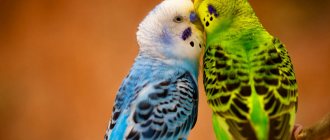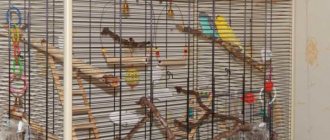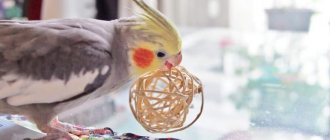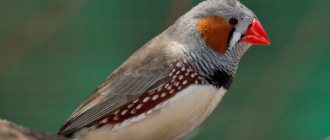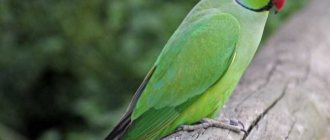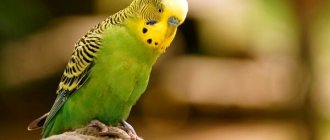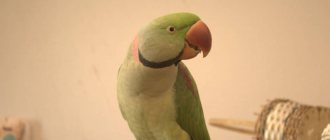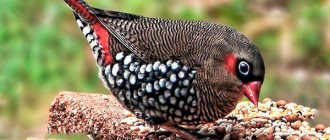What does a gray parrot look like?
Jaco is one of the largest parrots kept at home
Gray parrots are quite large in size: the length of an adult can reach 35 cm, the wingspan is 65 cm, and the tail length is about 8. The plumage has a noble gray shade of velvety texture, the bright accent of which is the purple-red tail. The yellow iris of the bird’s curious eyes and the curved black beak especially stand out against this background.
The varieties of these parrots are brown-tailed and king parrots.
The Royal Jaco is the rarest variety of this parrot.
The brown-tailed gray differs from the common gray not only in color, but also in its smaller size
What to be prepared for
Noise
Jaco is a very talkative bird. All the time he is awake, the gray parrot will say something and make sounds. The range and volume of his vocal capabilities are colossal.
You need to be prepared for noise from a parrot
He will communicate with you, with household members, with other animals, with TV, with radio, and with himself. There is no way to stop this fountain.
Therefore, correlate your desire to have these birds with your emotional capabilities and levels of patience.
Read also
Growth on the beak of a budgerigar
Garbage
Gray parrots are energetic birds. They love to chew and throw everything around. They have no idea about the accuracy of eating.
The entire space around the cage will be constantly strewn with all kinds of debris. And it will have to be cleaned constantly. Keep this in mind too.
Expenses
Everything is expensive. From the cost of the cage to a complete diet. The birds themselves are also not cheap. This is about money. And there are also time costs that no one can reimburse you.
Keeping a African Gray parrot is quite expensive.
How to choose the right one
When choosing a parrot, it is important to make sure that there are no fatty deposits on the body in the sternum area (checked by careful palpation)
It is best to purchase Gray parrots in pet stores or special nurseries, where the buyer will be able to provide all the necessary documents for them.
It is strictly not recommended to use the services of private sellers: for a very tempting price, you can become the owner of an old wild and sick bird, which will be impossible to tame.
Gray chicks raised in nurseries are especially kind, affectionate and friendly. They become true friends and favorites of all family members. Young individuals adapt to new conditions as easily and quickly as possible and begin to talk before the age of five months.
Important nuances that you should definitely pay attention to before purchasing will help you choose a healthy young parrot:
- active and cheerful behavior of the bird;
- integrity and natural purity of feathers;
- absence of residues of droppings and dirt in the area around the cloaca;
- no deposits in the nostrils;
- clear eyes of a dark gray hue (in birds older than a year, the iris begins to gradually lighten), “lively” look;
- smooth scales on the paws;
- smooth beak.
Advantages and disadvantages
The main advantages of the Gray parrot are:
- extraordinary intelligence and intelligence, allowing you to play with the bird, solve puzzles and riddles;
- a cheerful disposition and perky mood that can instantly dispel boredom;
- the ability to perform funny acrobatic stunts;
- excellent ability to learn, with the right approach to which the bird not only learns to reproduce speech and various sounds, but also does it according to the theme, causing incredible delight among listeners;
- showing a sense of affection and love for the owners;
- the noble beauty of the plumage, which calms and adds zest to the interior of the room where the bird is located.
There are also disadvantages:
- an abundance of debris (feathers, fluff, food particles, droppings);
- damage to various objects with a powerful beak;
- the likelihood of involuntary injury to a person;
- a rather complex character and an aggressive response to the owner’s dissatisfaction and aggression;
- considerable financial costs (cage, toys, food, visits to the veterinarian).
Causes of death
A bird can die from advanced, untreated diseases or injuries incompatible with life. It is impossible to leave the Gray alone flying freely around the house. He could get stuck somewhere and suffocate, get hurt on a sharp object, or get burned by an open flame. He is in danger of being electrocuted if, out of curiosity, he pecks at an electrical wire.
Left without attention and supervision, the bird becomes sad, its character deteriorates, its nervous system suffers, and its appetite disappears. All this can worsen to such a state that the pet dies.
For a Gray, a meeting with a cat or dog can end sadly. A parrot can fly out of a window or an open window and not return.
Poisonous indoor plants, such as azalea, aloe, amaralis, dieffenabachia, oleander, hydrangea and monstera, can lead to the death of a bird.
Care and maintenance
What to feed
The parrot is able to peel nuts on its own
For a parrot to be healthy, cheerful and talkative, its diet must be nourishing and balanced. It must include:
- practically all fruits and berries, vegetables (except avocados). They must be thoroughly washed and pitted, grains and porridges removed. Dry grain should not be given. It must first be soaked, allowed to swell, or even better, wait until it germinates. This is not difficult to do: the grains are washed, filled with water and left for a day in a warm place to swell. After this, they are washed again, transferred to a flat container, covered with a lid so that the moisture does not evaporate, and also left for a day, after which the grains germinate. Porridge is prepared in the same way as for people: the cereal is washed and boiled in water without salt, sugar and other additives until cooked. Legumes (including lentils) are served similarly;
- nuts (no more than 3–6 grains depending on size, as they are very fatty).
It is very important that all products are of high quality, fresh and without any additives.
As for ready-made store-bought food, experts advise treating it very carefully: if the parrot is accustomed to natural food, the bird’s body may not accept the artificial additives of (usually) imported food, reacting to unfamiliar food with an upset stomach.
The parrot should have free access to filtered or settled water at room temperature for 24 hours, which must be replaced daily.
Hygiene and bathing
An important hygiene procedure is cleaning the cage . It should be done at least once a week. During cleaning, absolutely everything is washed: feeders, water containers, toys, perches and the entire area of the cage. It is strictly forbidden to use chemical and toxic detergents for these purposes.
To maintain the ideal condition of the skin and feathers, the bird needs bathing . It can be done in various ways:
- Place a container with warm water (bathing bath, bowl) into which you can throw pieces of nuts or toys to interest the parrot.
- Spray the bird sitting in the cage with warm water from a spray bottle. Treating him with a treat after each spritz will help him get used to this method.
- Shower in the bathroom, bathing under the warm streams of which occurs according to the spray pattern from a spray bottle.
- Place wet lettuce leaves secured to the cage into the cage. Often, it is by rubbing themselves against them that gray parrots “take a bath.”
It is important to remember that it is strictly unacceptable to bathe a bird by force. If the parrot resists, it is better to postpone the procedure for a while.
Diseases and treatment
Self-plucking of feathers is one of the most common ailments that birds suffer from.
- Self-plucking a feather. A complex disease, the causes of which may be improper living conditions, nutrition, parasitic diseases, or psychological trauma. It can only be cured by establishing the underlying cause. To do this, you should contact an experienced ornithologist and only after that, a veterinarian who will prescribe the necessary medications.
- Diseases of the digestive system and poisoning . They arise from improper feeding or eating poor quality, toxic or food not intended for birds. This happens especially often when no one is watching the parrot moving freely around the rooms. The main symptom of indigestion is liquid “foamy” droppings with discoloration. In case of poisoning, vomiting, severe thirst, loss of coordination, trembling in the body, convulsions, and falling into a coma may occur. The appearance of any of the symptoms requires immediate consultation with a veterinarian. Most often, antibiotics, astringents, disinfectants, as well as a mandatory diet and plenty of fluids (chamomile tea, decoction of pomegranate peels) are prescribed for treatment.
- Parasites . There are feather, skin and internal. Their presence in a bird can be determined by the following symptoms: exhaustion, lethargy, sometimes excessive appetite, thin watery droppings, disheveled and faded plumage. Only a doctor can make an accurate diagnosis. Treatment boils down to the destruction of parasites by treating their habitats with special preparations prescribed by a veterinarian, as well as disinfecting the cage and personal items of the bird.
- Beak structural abnormalities. If it is not fed properly, unsightly growths may appear on its beak, as well as damage (cracking) of the horny substance. This often happens if the bird’s diet contains only soft food. To prevent beak enlargement, it is necessary to place a “bird stone” and tree branches (birch, apple, linden, rowan, maple) in the cage so that the parrot can sharpen it. If the beak has grown too much, it can be trimmed, but this procedure is quite traumatic for the bird, so it is better to entrust it to an experienced veterinarian.
Many owners are concerned that the gray parrot periodically clicks (creaks) its beak. As a rule, such sounds appear after eating. Ornithologists claim that such a sound is exclusively a manifestation of the bird’s pleasure and well-being, indicating good care.
Vaccination
For African Gray parrots, as for other bird species, there are special vaccinations. As a rule, they are done to chicks in nurseries, providing future owners with all the necessary information about previously performed manipulations. This allows you not only to purchase healthy birds, but also to minimize the costs of measures to prevent various diseases.
Some vaccinations will need to be repeated after a certain time, but this is still much easier than starting prevention (and even more so, treatment) all over again. All information about the timing of vaccination of a particular parrot should be checked with a veterinarian.
Choosing a cage and accessories for a parrot
All parrot accessories must be washed regularly
A properly selected cage in which the bird will spend most of its time will help provide your parrot with maximum comfort at home. When choosing a cage, you should focus on the following parameters:
- Size. The minimum acceptable living space dimensions are considered to be 65x45x80 cm. But if possible, it is worth purchasing a larger cage (one and a half to two times), especially if the bird will not live in it alone. At the same time, it is necessary to provide the gray parrot with the opportunity to take daily “walks” beyond its territory;
- Strength. Possessing high intelligence and a powerful beak, the gray parrot can easily leave its home at the “inappropriate” time, gnawing bars and opening simple doors. That is why it is important to pay attention to the choice of cages with a rod diameter of at least 2–3 mm and equip them with additional locks.
- Debris protection . It can serve as various insert panels made of plexiglass or plastic, which will become a kind of barrier to debris flying in all directions.
In addition, the cage must contain:
- feeders and a drinking bowl (preferably several, for different types of food), be sure to be securely fixed so that the bird cannot knock them over;
- special swing;
- various toys (educational, musical, for paws and beak);
- perches, sticks and twigs.
You can purchase a cage in specialized stores or make it yourself using durable galvanized mesh, which must be thoroughly cleaned, as well as a piece of plywood of the required size and slats for the pallet.
The Gray parrot does not like change, so it is highly not recommended to move its “home” from place to place. It is preferable to immediately install the cage in an area of diffused light (away from the window) and without drafts.
Garbage
Cleaning your apartment will now become at least two to three times more frequent. Fluff, leftover food and chips from chewed toys will be permanent inhabitants of your beautiful carpet. Most Grays eat like real pigs, and, despite the special protective partitions in the cage, pieces of fruits and vegetables mysteriously still end up on the floor. Grays can also tolerate being kept in a cage and go to the toilet only when free. It is possible to train a parrot to go to the toilet in a certain place, but experts advise not to torture the bird.
Breeding
In captivity, gray parrots reach sexual maturity at the age of three, but only if a male and female live together. That is why, for the purpose of breeding, it is recommended to immediately purchase a pair of parrots, between whom sympathy will arise over time. Mating often occurs from late spring to mid-autumn.
How to determine gender
To accurately determine the sex of a parrot, it is better to contact a specialist.
Due to the fact that the external differences between the female and the male are very weakly expressed, it is quite difficult to determine gender. You need to focus on visual features:
- The male's head is wider than that of the female, and the crown is slightly flattened. The hook of the massive beak is also large. The bare area around the eyes is wider.
- Females have a narrower, rounder and smaller skull. The pelvis is wider, which can be seen by the greater distance between the upper parts of the thigh bones and legs. The feathers on the belly are usually lighter than those of the male.
Mating
Breeding parrots is best done on neutral territory, without introducing birds to each other. An enclosure is suitable for this, where after exploring the territory the male will perform a “mating dance”.
Pregnancy
Female Grays are responsible and caring mothers
After some time, the female lays a clutch of 3–5 eggs the size of pigeons. This process can take a week with intervals between layings of several days. To lay and incubate eggs, it is necessary to equip a nesting box in the cage (at least 30x30x30 cm).
The female sits on the eggs for about a month, almost never leaving the nest. Throughout this entire period, the responsible and devoted “future father” carefully feeds and protects her, continuing to do this even after the birth of the chicks, while the female is next to them.
How to care for chicks
A daily inspection of the chicks is necessary: healthy birds look plump and their skin is well stretched.
The chicks are born with their eyes closed (they open only in the third week) and covered with gray fluff. For a month, the female stays in the nest, taking care of the cubs in every possible way (feeding, warming) until they independently begin to fly out for food. At the age of three months, the chicks leave the nest, but still remain under parental care. At this time, feeders with soft food should be equipped for babies at the level of the perches.
If one of the chicks has wrinkles, it is urgent to either feed the baby or remove it from the nest and feed it artificially.
Chicks destined for the role of pets are also taken from the nest at the age of one and a half months and fed by hand, which allows them to establish contact with people, making them docile and sociable.
Training and playing with your pet
Sometimes it takes a long time to tame a gray parrot
Owners of gray parrots raised in nurseries do not need to worry about how to tame them, since such birds are fully prepared to communicate with people.
The situation is somewhat different with savages, whose trust still needs to be earned. The following recommendations will help speed up and successfully establish this process:
- After purchasing a bird, you should minimize communication, completely eliminate loud sounds, sudden movements, and only observe the pet’s behavior and preferences from afar.
- After a month, you can try offering your parrot his favorite treat through the bars of the cage without putting your hand inside.
- The next step is to give treats from your hand outside the cage. It is important to remember that the bird itself should approach the person, and not vice versa.
The complete disappearance of the parrot's fear of humans and the establishment of contact can be indicated by its standing on the owner's hand in order to take a treat. A lot of time can pass before this exciting moment, and a person’s main task is not to insist, but to wait patiently, providing his pet with the most comfortable living conditions and proper care.
After establishing friendly relations with your gray parrot, you can safely begin a variety of joint games (tug of war, collecting pyramids, throwing a ball, football) and educational activities.
Learning to imitate speech requires adherence to certain rules:
- You can start training when the bird is three months old;
- a prerequisite is a good mood and health of the parrot;
- classes should not last longer than 15 minutes;
- learning should begin with short words and phrases, pronouncing them in a chant with a certain intonation;
- important words and expressions must be given an emotional connotation;
- words and phrases should be selected taking into account the content of the sounds that are easiest to reproduce (k, s, t, r, ch, sh).
On average, a gray parrot is able to remember and pronounce about a hundred words.
Intelligence level
The cost of a gray parrot is considerable, since this bird is one of the smartest birds on the planet. Scientists compare the intelligence level of a Gray Gray and a five-year-old child. In brown-tailed birds, the ability to remember words appears earlier than in red-tailed birds.
Domestic Grays are smart and emotional, each parrot has its own character and excellent memory. He needs communication and movement. You can't buy it off with toys alone. You have to play with him. Jaco will be happy to participate in all games and activities of the owner. He will be interested in a computer, TV, washing machine and hair dryer. You will have to allow the bird to explore these things, otherwise it will be offended.
Lifespan
A significant role in the life expectancy of a parrot is played by the correct provision of necessary assistance in case of illnesses and possible injuries.
It depends on complete proper care and safety outside the cage.
In comfortable conditions, the average life expectancy of a Gray Gray is about 25 years. The maximum age of parrots of this species is about 50 years.
What to name a parrot
Choosing a name for a future pet should always be taken responsibly
Names for boys
There are many options for nicknames for male parrots. You can use your own imagination or choose the following:
- Alex.
- Diamond
- Alf.
- Amur.
- Archik.
- Bert.
- The battle.
- Boss.
- Bruce.
- Zipper.
- Vinnie.
- Gosh.
- Grandee.
- Danko.
- Dandy.
- Joe.
- Erosh.
- Jacques.
- Zenith.
- Marshmallow.
- Jiri.
- Charles.
- Kane.
- Makar.
- Nick.
- Okar.
- Patrick.
- Roger.
- Typhoon.
- Felix.
- Charlie.
- Elon.
- Yasha.
Names for girls
When choosing a nickname for a girl, you can focus on the characteristics of her appearance and character, or use the list of suggested ones:
- Adele.
- Assol.
- Beauty.
- Venus.
- Vita
- Wally.
- Gressi.
- Jerry.
- Dune.
- Geri.
- Zara.
- Inza.
- Kiwi.
- Button.
- Lada.
- Like.
- Monica.
- Nancy.
- Ollie.
- Pike.
- Roni.
- Sandra.
- Ulli.
- Flory.
- Holly.
- Chang's.
- Chucha.
- Sheri.
